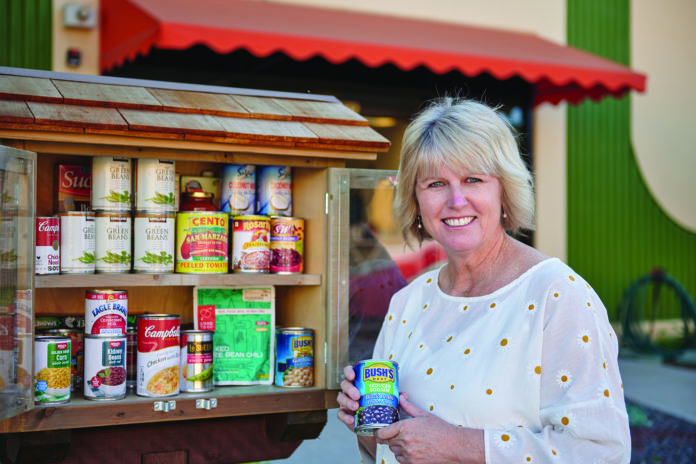by Nancy D. Lackey Shaffer
Food Share of Ventura County fulfills a vital purpose: Providing food to the many people in the area who need it. That amounts to hundreds of thousands of Ventura County residents since its inception in 1978. Leading the charge today is President and CEO Monica White, who took over leadership in 2017 after 13 years as director of marketing and circulation at the Ventura County Star. Since then, Food Share has seen food insecurity grow, following numerous wildfires and now the COVID-19 pandemic . . . and the organization, its staff and numerous volunteers have not hesitated to rise to the challenge. We spoke with White about food insecurity in the county today, how Food Share is meeting that need and what more remains to be done.
VENTANA MONTHLY: Are you from Ventura County originally?
MONICA WHITE: My husband and I moved to Ventura 20 years ago to raise our family in a safe and friendly community. Despite the two decades we’ve been here, I still consider myself a newbie. Hearing people refer to the VC Star as the Star-Free Press and meeting the dozens of multi-generational agriculture families has opened my eyes to the deep legacy of Ventura County.
I understand that you were originally a member of Food Share’s board before being named CEO. What inspired you to get involved originally? And why did you decide to make the jump to CEO?
I first became involved for the simple reason that I believe the mission is critically important. Food is a basic need and it’s not right when people in our own community have to struggle with the stress of food insecurity. Having served on the Food Share board, I knew that the organization was supported by an incredible team of dedicated staff and volunteers. It was truly a privilege to step in, initially as the interim CEO, and I was honored when the position was offered to me on a permanent basis.
What sorts of changes did you make, if any, after becoming CEO?
When I joined, the organization was facing significant financial challenges, which required some sizable cutbacks and organizational changes. It takes a considerable infrastructure and complex supply-chain operation to acquire, store and distribute multi-millions of pounds of donated and purchased food annually. I’m pleased to say that with some well thought out changes, we’ve been able to improve efficiencies in all areas of our operation, to the point now that 96 cents of every dollar donated goes directly to feeding people in need.
How pervasive is food insecurity in Ventura County?
Even in normal circumstances, an estimated 1 in 6 people in Ventura County experiences food insecurity, meaning they don’t always have access to a sufficient quantity of affordable, nutritious food. That number includes more than 40,000 children.
What are some of the biggest challenges with meeting the needs of those who require Food Share’s assistance?
Since the onset of COVID-19, the biggest challenges have been purchasing, storing and packing enough food to meet the increased demand. We’ve increased the amount of food we purchase each month from $50,000 to $400,000. That’s been a challenge financially, and also in terms of storage space.
We have 36,000 square feet of warehousing space at our Oxnard facility, but with the additional inventory we were bursting at the seams. We were very fortunate that local businessman Lawrence Joss has provided us with an additional warehouse for free, temporarily.
We’re using that new space to not only store food but also pack the 250,000 emergency food boxes we’ve distributed since the beginning of April, with the help of the 146th Airlift Wing of the California Air National Guard.
Since you became CEO, Ventura County weathered two very damaging fires — Thomas in 2017 and Woolsey in 2018. Did those events impact food insecurity? And if so, how did Food Share respond?
The fires did impact food insecurity, but not in any way close to what we’ve seen with the pandemic. We did see a pretty significant increase in the number of service workers seeking our assistance — housekeepers, dog walkers, gardeners, pool cleaners and so on — who saw an immediate drop in revenue when their clients’ homes were lost in the fire. Fortunately, we’ve been able to work closely with our network of pantry partners to ensure there was additional food available to meet the increased need.
The COVID-19 pandemic has, of course, changed a lot of things for a lot of people, including in Ventura County. Did Food Share see its client base grow? How were you able to meet the additional need?
Before the pandemic, many of the families Food Share served would need supplemental food perhaps two-three times a year. Most were low-income working families.
Since the onset of the COVID-19 pandemic, we’ve seen an unprecedented rise in need in addition to the 75,000 people we typically served on a monthly basis. Our latest estimates suggest the number is closer to 150,000 as low-income families in our community have borne the full brunt of the layoffs and reduced hours in all sectors.
In addition to those in the service and hospitality sectors, we’ve also seen an increased need among farm workers, many of whom have had their hours cut as the demand for fresh produce from schools, restaurants and entertainment venues was depleted.
How did Food Share’s work change as a result of pandemic-related shutdowns and restrictions?
As an organization we exist to help people who are going through difficult times — hunger, after all, is a disaster for every individual who has to experience it, regardless of the cause. Disasters like this pandemic just bring more attention to a problem that exists every day.
Of course, what we’re now experiencing is food insecurity on a much bigger scale. At the beginning of the pandemic, nearly 25 percent of our network of pantry partners suspended distribution, which left a real gap in the community at a time when people needed food the most.
We’ve responded by holding more than 200 drive-thru emergency food distributions in locations all over the county — providing food direct to the community. We’ve also significantly increased the amount of food we purchase, to ensure that our pantry partners that have remained open have enough food to meet the need.
Ventura County recently moved from the purple to the red tier…are you seeing any changes as a result of that?
Not yet. People are still out of work in record numbers, or trying to regain their footing after lost income over the past 8 months. Even if people are now finding jobs, many are dealing with the issue of underemployment — like a woman I met last week, working at a local coffee chain, who can only work a few hours a week because the kids are not in school. She told me what a life saver it is to be able to pick up a box of food at one of our local pantries.
I don’t think we’ll see a significant drop in demand for food for many months to come. Until the pandemic is well and truly over and the economy starts to recover, we expect to continue feeding those in need for months or even years to come.
Looking at the big picture of food insecurity, what do you think are the primary problems creating that? Is it the cost of food, the ability to access it, something else?
Food insecurity may seem like a complex issue, but at its root, it’s closely tied to income inequality. There’s a perception that we just serve the homeless, but the reality is that the vast majority of the people seeking assistance are the working poor — people who are employed but in low-income jobs and often living expense to expense.
To give some context, the median salary for a full-time minimum wage employee in Ventura County is approximately $31,200 a year. After taxes, take home pay is less than $2,000 a month. Even if two or more people in a household are working, if it’s in a low-wage job, that’s still desperately little to live on in Southern California. But sometimes it’s still too much to qualify for food assistance programs like SNAP or WIC.
It’s scenarios like these that lead people to seek our assistance. They play out in thousands of homes across the county. Sadly, with increased rates of unemployment and underemployment from reduced hours, the pandemic has only worsened the problem.
Based on your time with Food Share, what do you think is necessary for addressing food insecurity on a large scale? Do you see economic assistance or policy playing a role? What kinds of things would keep people from needing the assistance of Food Share and other food banks?
That’s a huge question, with no single, straightforward answer. While I would like to think with hard work, collaboration and community support, it’s possible to end hunger, in reality, I don’t see that happening in my lifetime. Are there opportunities to further support those in need with other services that will ultimately help them put food on the table? Absolutely. But for now, our role as the food people is to serve those in need and while others are welcome to figure out how to shorten the line, we’ll be feeding the line.
What are the biggest challenges of your job? What are the biggest rewards?
In many ways, the challenges are the rewards. We distributed 17 million pounds of food last year. It takes a lot of people and infrastructure to do that efficiently, which certainly brings its fair share of challenges. But I’m rewarded by working with a truly awesome team of staff, volunteers and organizational supporters. The biggest reward of all comes from seeing the appreciation of the people we serve. That’s really special.
What plans do you have for the future of Food Share?
We’ve been in our current location for 35 years. It’s served us very well, but we’re now at a pivotal point where if we’re to continue to serve the number of people in need with the quality of food they deserve, then we need to take a hard look at expanding our facilities. Despite COVID, we’re excited to be moving forward with the studies and analysis to determine what we need to meet the need for the next 40 years.
Is there anything else you might like to share with Ventana’s readers about Food Share or yourself?
I’d like to share my huge appreciation for the support we’ve received from so many individuals and organizations in our community. As a nonprofit organization, our donors and our volunteers are critical in enabling us to do what we do. Of course, we always need more help and more donations, whether that’s a monetary donation or a food donation! This has been a tough year for everyone, but with continued support from our community no one in Ventura County needs to worry about going hungry.






















